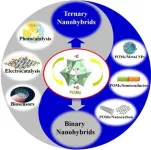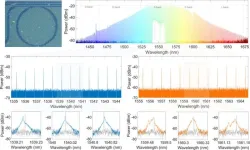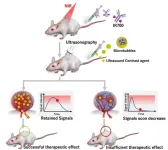A new class of nanoscale hybrid materials has the potential to improve sustainability across energy systems, transport, biosensors, water purification and even 3D printing, but the field is still very young. A group of researchers has produced a detailed overview of the state of play in polyoxometalate (POM)-based nanohybrids, charting a path for research in this cutting-edge realm of materials science.
A review paper detailing their findings was published in the journal Polyoxometalates on September 30.
In recent decades, a novel class of nanoscale materials, or more simply nanomaterials, has emerged in which a single unit enjoys dimensions in the range of 1-100 nanometers. At this scale, materials can exhibit unique and often enhanced physical, chemical, and biological properties that differ from more massive or ‘bulk’ materials. For example, nanoscale materials can have a higher surface area-to-volume ratio, which can increase their reactivity and ability to catalyze (kick off or speed up) chemical reactions.
Perhaps the most well-known nanomaterial is graphene, but nanomaterials can be built out of a wide range of substances, including metals, semiconductors, ceramics, and polymers. More recently, researchers have also developed nanohybrids. These are substances that combine two or more different types of nanomaterials.
Of particular interest to researchers, especially those aiming to make industrial production more sustainable, are polyoxometalate (POM)-based nanohybrids, which have unique catalytic properties within photoelectrochemical reactions—those that generate electricity from light, or split water into cleanly produced hydrogen and oxygen. This makes the POM nanohybrids promising candidates for a wide range of applications including clean energy conversion and storage, as well as sensors and electronics that do not depend on the use of dirty energy sources.
POMs are a very large class of cheap and stable inorganic compounds that consist of metal ions, typically transition metals such as tungsten or molybdenum, linked together by oxygen atoms to form a three-dimensional network. POMs are typically large, complex molecules that can have a wide range of shapes and sizes, and they exhibit a variety of interesting and useful properties.
“There’s been an explosion of research into POM nanohybrids in the last few years, and so we thought it time to pause, and produce an overview of the current state of play in order to identify potential research gaps and controversies,” said Guangjin Zhang, corresponding author of the review paper and a chemist at the Key Laboratory of Green Process and Engineering with the Chinese Academies of Sciences.
Scientific review papers are an essential part of the scientific process, aiming to summarize and critically evaluate the current state of knowledge on a particular topic in a given field of science, assess the quality and reliability of the existing literature, and suggest future research directions.
The authors of the review conclude in their review that what makes POMs so attractive is how they can enhance the photoelectrochemical catalytic properties of the resulting nanohybrid material. This is because POMs can act as both electron acceptors and donors, which allows them to facilitate the transfer of electric charge and improve the efficiency of the relevant reactions. Better still, POMs can also act as catalysts themselves, further enhancing the catalytic properties of the nanohybrid material.
The review also explains the difference between binary and ternary POM-based nanohybrids, the former consisting of two functional nanoscale materials, and the latter consisting of three. The binary nanohybrids combine POM and a metal, POM and a semiconductor, or POM and a nanocarbon, while ternary nanohybrids combine a POM, a metal and a nanocarbon.
The authors note that binary nanohybrids have been extensively studied and have shown promising results in a variety of applications, including photocatalysis, fuel cells, and biosensors. Ternary nanohybrids meanwhile have the potential to combine the unique properties of three different materials, resulting in even greater functionality and versatility.
One of the most promising areas of research into POM-based nanohybrids of both types comes from their use in photocatalysis—using light to drive chemical reactions. POM-based nanohybrids have the potential to improve the efficiency of photocatalytic reactions, which could have important applications in fields such as solar energy conversion and environmental remediation. The nanohybrids may also enjoy applications in fuel cells, which are devices that convert chemical energy into electrical energy, as for example in hydrogen-powered transport. POM-based nanohybrids have the potential to improve fuel-cell efficiency and durability.
Another area unrelated to sustainable energy where POM-based nanohybrids show great promise involves their application in biosensors, devices that detect and measure biological or chemical substances in a sample via changes in electrical signals resulting from biochemical reactions. The nanohybrids’ high surface area and ability to immobilize biomolecules, amongst other properties, make them especially well-suited for use in such devices. Already, researchers have used POM-based nanohybrids to develop biosensors that can detect substances like simazine and hydrogen peroxide with high sensitivity. These biosensors have the potential to be used in a wide range of applications, from medical diagnostics to environmental monitoring. Other emerging applications include water purification, semiconductors and 3D printing.
One of the main challenges researchers in this field face is that while ternary POM-based nanohybrids offer even more enhanced performance, for the moment, research is still in its infancy, with a more limited understanding of ternary nanohybrid properties and behavior. Their potential applications are still being explored and there may be challenges related to developing and optimizing ternary nanohybrids for specific applications. In addition, for all types of POM-nanohybrids, the solubility of POM molecules in the hybrids can degrade their performance as catalysts. Their non-uniform dispersion on and in conductive substances also remains a persistent problem, and when combined with metals or metal oxides, control of the size and shape of the particles is difficult.
The authors argue that greater focus on a foundational understanding of the relationship between the structure of the hybrids and their chemical activity should assist in overcoming these obstacles to broader applications, and call for wider cooperation across different disciplines to do so.
##
About Polyoxometalates
Polyoxometalates is a peer-reviewed, international and interdisciplinary research journal that focuses on all aspects of polyoxometalates, featured in rapid review and fast publishing, sponsored by Tsinghua University and published by Tsinghua University Press. Submissions are solicited in all topical areas, ranging from basic aspects of the science of polyoxometalates to practical applications of such materials. Polyoxometalates offers readers an attractive mix of authoritative and comprehensive Reviews, original cutting-edge research in Communication and Full Paper formats, Comments, and Highlight.
About SciOpen
SciOpen is a professional open access resource for discovery of scientific and technical content published by the Tsinghua University Press and its publishing partners, providing the scholarly publishing community with innovative technology and market-leading capabilities. SciOpen provides end-to-end services across manuscript submission, peer review, content hosting, analytics, and identity management and expert advice to ensure each journal’s development by offering a range of options across all functions as Journal Layout, Production Services, Editorial Services, Marketing and Promotions, Online Functionality, etc. By digitalizing the publishing process, SciOpen widens the reach, deepens the impact, and accelerates the exchange of ideas.
END






